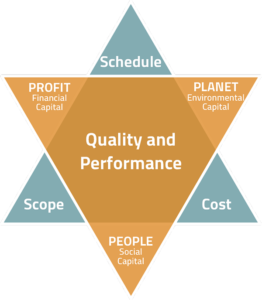LBNL’s Guide for High Performance Buildings Released
Singh, Ravache and Sartor author groundbreaking guide for energy efficient buildings in India as part of Lawrence Berkeley National Laboratory intellectual contribution to the US-India Strategic Energy Partnership.
Lead author Reshma Singh is Program Director of the Department of Energy’s Center for Building Energy Research and Development (CBERD) at the Lawrence Berkeley National Lab. Reshma is also mentoring in STEM, she has co-founded education platform GreenExcel and she is recipient of Harvard University’s Community Service Fellowship award.
ADL Ventures is interested in key findings around building automation and control systems and their huge potential energy efficiency impact. As it is stated: “One of the key technologies recommended in the Building Innovation Guide is a building energy information system (EIS) that can enable up to 20% whole building energy savings.“
Building Innovation Guide: Best Practices
U.S. Secretary of Energy Rick Perry and India Minister of Petroleum and Natural Gas Dharmendra Pradhan recently launched a Strategic Energy Partnership that includes a significant intellectual contribution by Lawrence Berkeley National Laboratory (Berkeley Lab).
Building Innovation: Guide For High-Performance Energy-Efficient Buildings in India, is a document packed with best practices for smart, innovative buildings that will help improve India’s energy security by reducing energy demand, while also showcasing U.S. technology and service providers.
The Building Innovation Guide was funded by the U.S. Department of Energy; findings were presented at the U.S. Green Building Council’s signature Greenbuild Conference held in Mumbai in November 2017.
“The Building Innovation Guide synthesizes years of U.S. buildings R&D, computer simulations, and on-the-ground research in India to articulate a set of strategies that can propel energy-efficient commercial building design and operations into the mainstream,” said Reshma Singh, Program Director of the U.S. India Center for Building Energy Research and Development at Berkeley Lab. “Because of the extraordinary amount and pace of new construction in India, the buildings sector is now recognized as a key area to reduce energy consumption and a growing market opportunity for U.S. manufacturers.”

Energy Conservation
India is poised to become the world’s fifth largest economy, with the buildings sector representing over 30% of the nation’s energy consumption. India launched the Energy Conservation Building Code (ECBC) in 2007 and updated it in 2017. Energy conservation is an important part of India’s overall energy plan, and this ambitious first step will contribute significantly to the nation’s ability to sustain its growth. Pioneering early adopters—building developers, owners, architects, engineers, and consultants—have taken the lead in designing customized solutions. However these are often one-off projects, and there is an articulated need to demystify metrics, processes, and technologies that can enable high-performance buildings. The Building Innovation Guide offers a synthesized perspective for energy-efficient and high-performance buildings.
The Building Innovation Guide offers insights that are responsive to the emerging spatial aspirations of a growing, young, skilled workforce; and the nation’s specific climatic, cultural, and construction contexts.
a previous version published in 2013
The document builds on the work presented in a previous version published in 2013, as well as the US-India collaborative Center for Building Energy Research and Development (www.cberd.org). The new Building Innovation Guide presents a set of India climate-specific energy performance models, and targets; a life cycle approach; case studies of exemplary buildings, a prioritization framework for selection of strategies; and a list of technologies and services that showcase high quality building providers.
Core Principles
The Building Innovation Guide provides recommendations for the intersecting building physical systems: mechanical systems for HVAC, electrical equipment (plug loads), lighting, and envelope/passive systems. These building systems may be integrated through a backbone of building information technologies throughout the building.
Three core principles inform the recommendations:
A triple bottom-line framework for energy-efficiency decision making with an enhanced view beyond first cost, to include consideration of human, financial, and environmental capital
Aggressive but achievable energy performance targets across various buildings stakeholders i.e., owners, developers, modelers, architects, engineers, facility managers, operators, product industry, and policy makers to collaboratively advance the state-of-the-practice
A building lifecycle approach i.e., design, construction, and operations. This can help mitigate the gap between intended and actual performance of the building
“These recommendations are localized to the climate zones of India, and are based on a triangulation of monitored data from exemplary projects (presented as “Data Points”), modeled data from building energy simulations (presented as “Simulation Results”), as well as experts’ inputs. Presented as “Tables of Metrics”, the climate-specific benchmarks provide visibility and proof of concept of how real buildings can target and achieve high performance,” said Singh. “We hope this guide will provide the knowledge for industry to identify what products are suitable for specific Indian climatic zones, inform design and procurement decisions, and provide a model for other emerging economies across the world. We look forward to seeing India propelled into the next frontier of digitization and decarbonization in its expanding building sector: energy-efficient processes, resources, and products that affect positive change, and drive strong environmental and societal impact.”
Industry Accolades
“There is a lot of excitement in the buildings science and energy world, including from the Indian government. My students in the architecture school are becoming more aware of energy efficiency as a core principle and need the right tools and training. The Building Innovation Guide can become a part of the educational curriculum easily.”
— Gayathri Aaditya, Department Head, NITTE School of Architecture, Bangalore
“Berkeley Lab has played a key role in shaping Infosys’ energy efficiency strategy for high performance campuses and has helped us leapfrog in our journey to become carbon neutral. The Best Practices Guide for Indian buildings has been really valuable for me and my team.”
— Swapnil Joshi, Regional Manager – Infrastructure and Green Initiatives, Infosys
“I look forward to using the Building Innovation Guide as a valuable resource in our M.Tech program in Buildings, Energy, and Environment.”
— Prasad Vaidya, Area Chair, Building Energy Performance at CEPT University, Ahmedabad India
Enabling 20 Percent Savings
As India embarks on a national smart meter rollout, one of the key technologies recommended in the Building Innovation Guide is a building energy information system (EIS) that can enable up to 20% whole building energy savings. An EIS technology comprises smart interval meters, communication gateways and software analysis with visualization. Energy data-based insights can enable facility managers and executive leadership to take actions and make investments that reduce peak loads, lower utility bills, and conserve energy, resulting in operational cost savings and environmental benefit.


